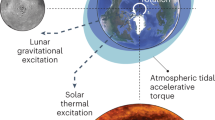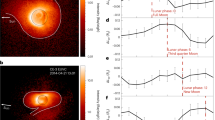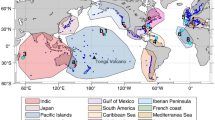Abstract
The concept of Stonehenge I as an accurate predictor of eclipses can be criticised on the grounds of inadequate short-term precision, unnecessarily good long-term tracking of the lunar nodes, and irrelevance to cultural needs. A more practical application of the astronomical characteristics of the structure is that of lunar apogee tracking, which would allow prediction of minimum tidal disturbance to cultural communication across the North Sea and English Channel.
This is a preview of subscription content, access via your institution
Access options
Subscribe to this journal
Receive 51 print issues and online access
$199.00 per year
only $3.90 per issue
Buy this article
- Purchase on Springer Link
- Instant access to full article PDF
Prices may be subject to local taxes which are calculated during checkout
Similar content being viewed by others
References
Hawkins, G. S., Nature, 200, 306–8 (1963); 202, 1258–1261 (1964); Antiquity, 41, 91–92 (1967); Stonehenge Decoded (Souvenir, London, 1966); in Vistas in Astronomy, 10 (edit. by Beer, A.), 45–88 (Pergamon, London, 1968).
Atkinson, R. J. C., Stonehenge (Hamish Hamilton, London, 1956); Nature, 210, 1302 (1966); Antiquity, 40, 212 (1966); 41, 63 (1967); 41, 92–5 (1967).
Sadler, D. H., Nature, 211, 1119–1121 (1966); Antiquity, 41, 97–8 (1967).
Colton, R., and Martin, R. L., Nature, 213, 476–8 (1967), and 221, 1011–2 (1969).
Newall, R. A., Antiquity, 41, 98 (1967).
Hawkes, J., Antiquity, 41, 174–180 (1967).
Hoyle, F., Nature, 211, 454–6 (1966); Antiquity, 40, 262–276 (1966); From Stonehenge to Modern Cosmology (Freeman, London, 1972).
Newham, C. A., Nature, 211, 456–8 (1966); Antiquity, 41, 96–7 (1967); Yorkshire Post, March 16, 1963; The Enigma of Stonehenge (Privately printed, 5 Sedge Rise, Tadcaster, Yorkshire, UK, 1964).
Robinson, J. H., Nature, 225, 1236–7 (1970).
Suess, H. E., in Radiocarbon Variations and Absolute Chronology (edit. by Olsson, I. U.), plate I (Wiley, New York, 1970).
Clark, R. M., and Renfrew, C., Nature, 243, 266–270 (1973).
Ottaway, B., and Ottaway, J. H., Nature, 250, 407–8 (1974).
Renfrew, C., Before Civilisation (Jonathan Cape, London, 1973).
Thom, A., Antiquity, 41, 95–6 (1967), in Vistas in Astronomy (ed. Beer, A.), 7, 1–57 (1966); in Vistas in Astronomy (ed. Beer, A.), 11, 1–29 (1967); Megalithic Lunar Observatories (Oxford 1971).
Thom, A., Thom, A. S., and Thom, A. S., J. Hist. Astron., 5, 71–90 (1974); J. Hist. Astron., 6, 19–30 (1975).
Sparks, B. W., and West, R. G., The Ice Age in Britain, Fig. 9.9 (Methuen, London, 1972).
Admiralty Tidal Stream Atlas NP233, Dover Strait. Hydrographic Dept, Taunton, Somerset, England.
Defant, A., Physical Oceanography, 2, 481 ff., and Charts III and IV (Pergamon, Oxford, 1971).
Author information
Authors and Affiliations
Rights and permissions
About this article
Cite this article
Beach, A. Stonehenge I and lunar dynamics. Nature 265, 17–21 (1977). https://doi.org/10.1038/265017a0
Received:
Accepted:
Issue Date:
DOI: https://doi.org/10.1038/265017a0
Comments
By submitting a comment you agree to abide by our Terms and Community Guidelines. If you find something abusive or that does not comply with our terms or guidelines please flag it as inappropriate.



